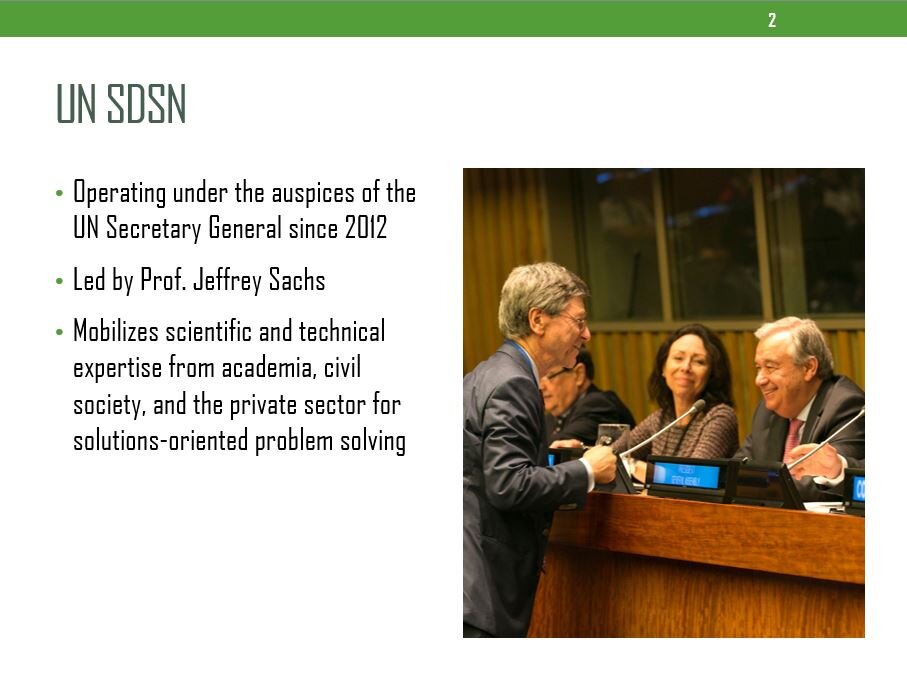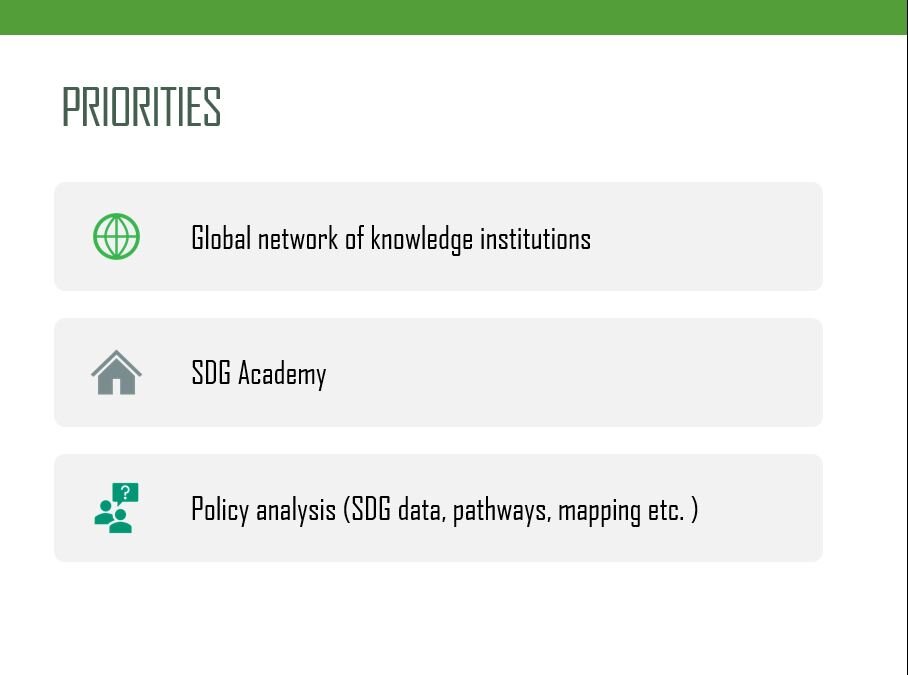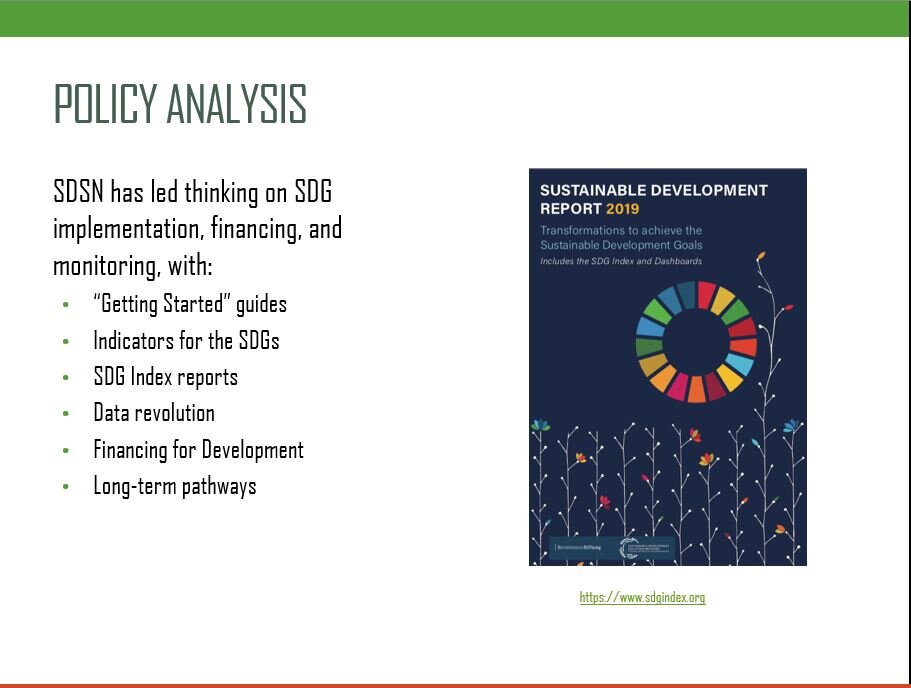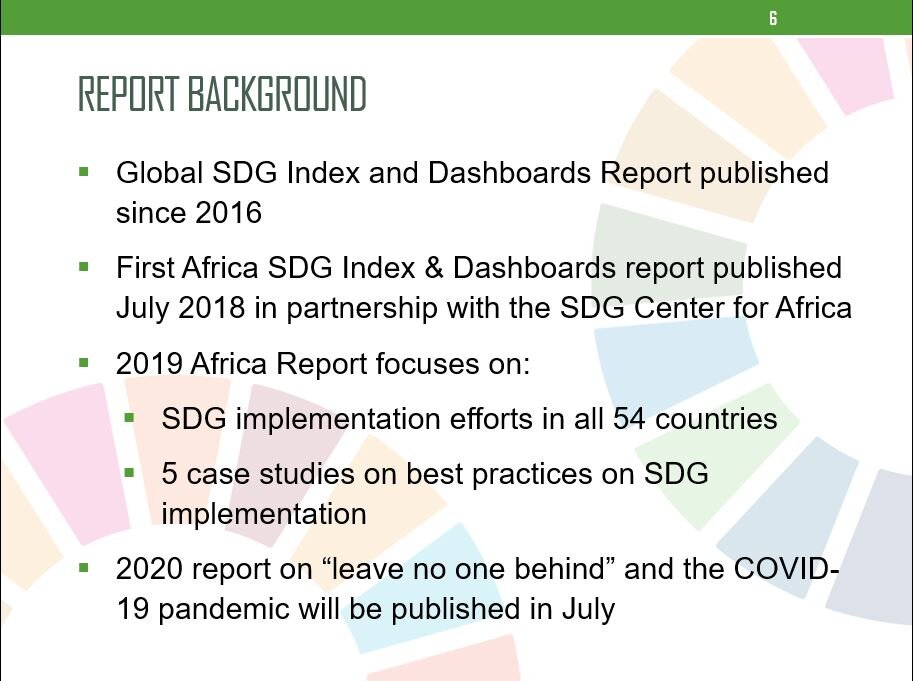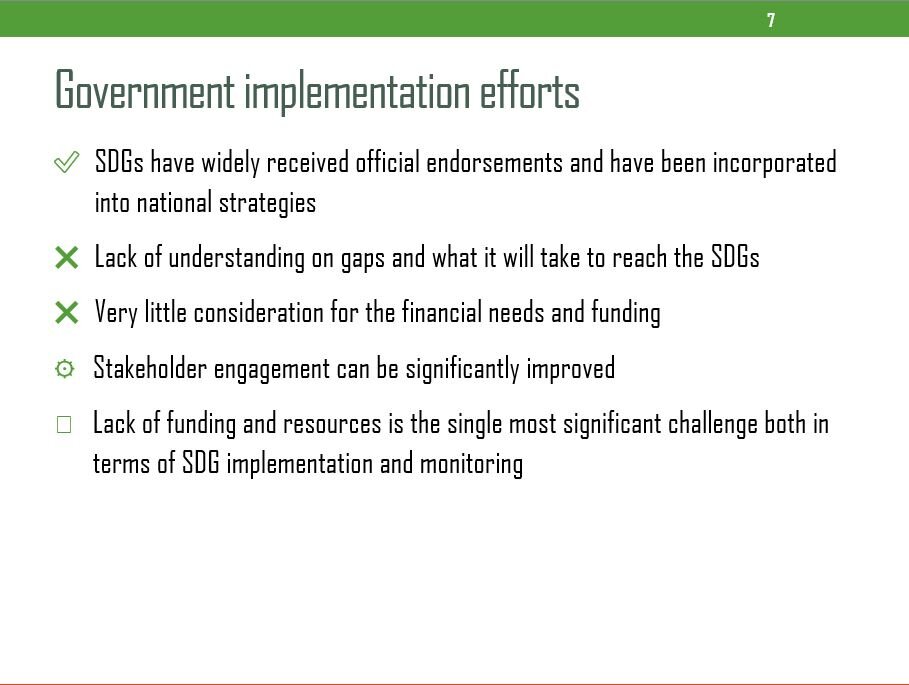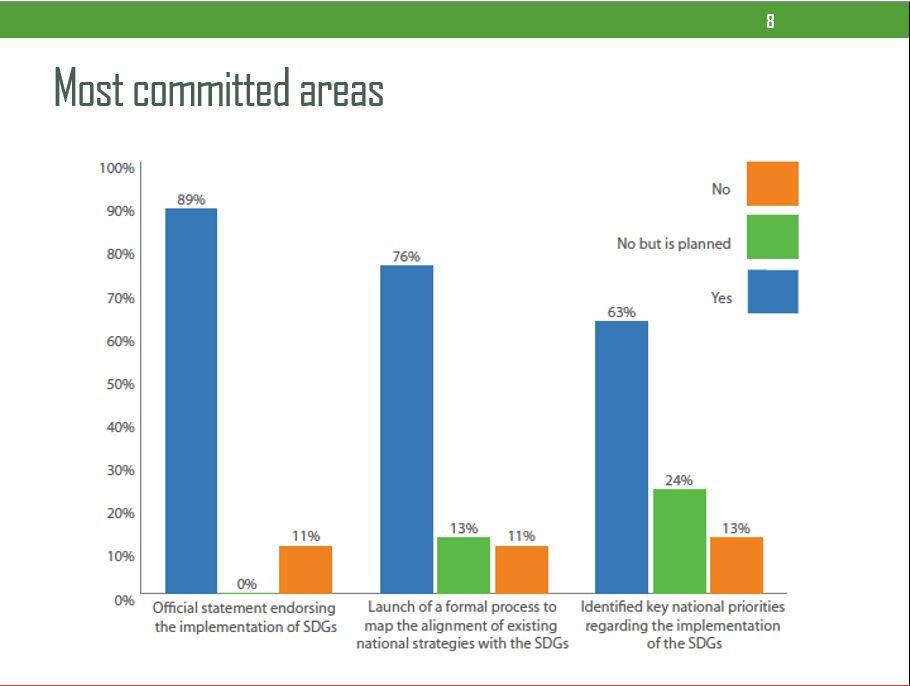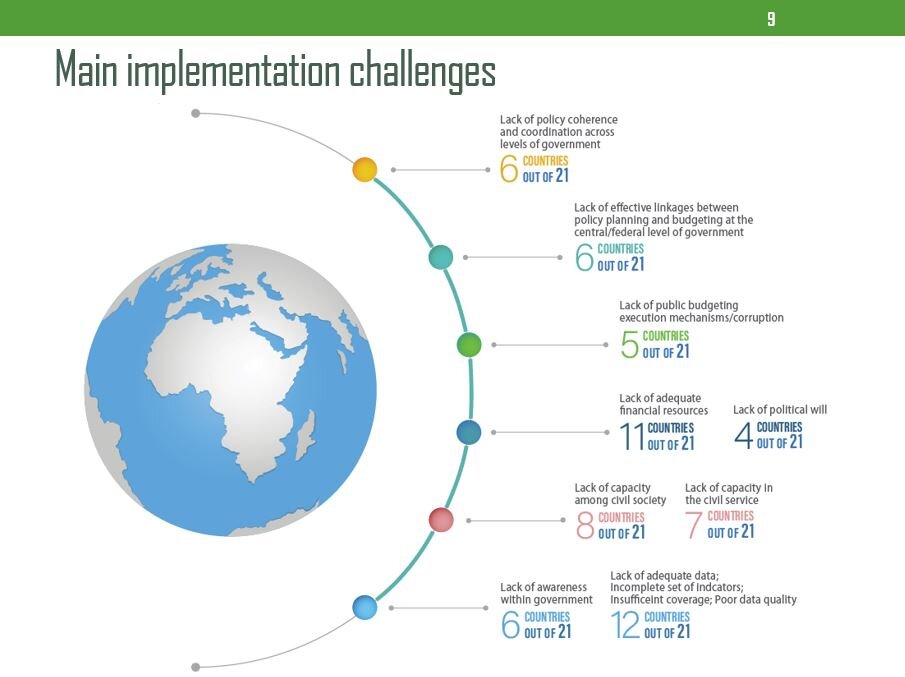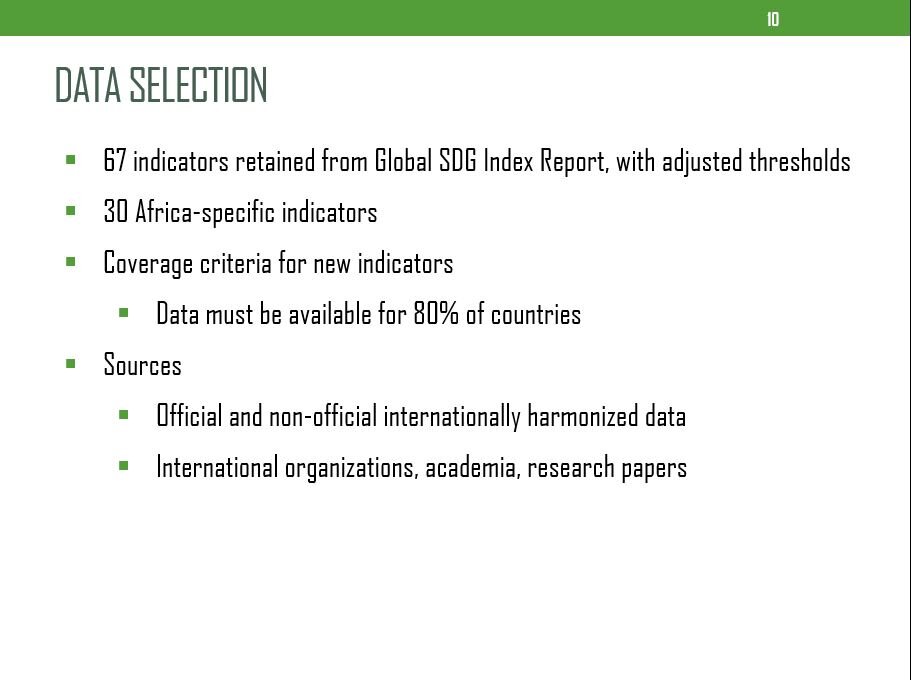Eve de la Mothe Karoubi, a Senior Manager for the UN Sustainable Development Solutions Network speaks on SDG progress in Africa on World Environment Day 2020.
LISTEN TO PODCAST
ABOUT THE SPEAKER
Eve de la Mothe Karoubi is a Senior Manager for the UN Sustainable Development Solutions Network. Previously, she worked for the OECD on capacity building in developing and emerging economies.
ABOUT THE MODERATOR
Caleb is an environmental and energy lawyer (Templars) and the founder and team lead (Earthplus) an environmental nonprofit organization delivering sustainable environmental solutions across Africa.
PRESENTATION
Q & A (SELECTED)
Caleb Adebayo: With only ten years to the deadline of Agenda 2030, can you boldly say that Africa is on track towards achieving sustainable development? Give reasons for your answer.
Eve de la Mothe Karoubi: Sure yes, I actually had a few slides to share that can illustrate and support exactly what I'm saying. Essentially Africa is not on track to achieve the SDGs by 2030 not by a long shot. But there's also a lot of disparities and heterogeneity between African countries and I will like to share the results of some research that we've done in the context of our SDG index work. So just as a word of background, my organization the Sustainable Development Solutions Network. We operate under the auspices of the UN Secretary-General and we are led by Professor Jeffrey Sachs who will be speaking to this webinar a little bit later and our mission is to mobilize universities and specifically the scientific and technological and technical expertise to identify solutions for the SDGs. So we have a global network of knowledge institutions with almost 2,000 universities and research centers around the world all working on these issues of sustainable development. We also have an online teaching component called The SDG Academy which offers a number of free resources for teaching the SDGs and we also do policy analysis and this is the one that I'm going to be sharing some information about. So on policy analysis and SDSN has been leading thinking on many different aspects of an SDG implementation including financing, monitoring, getting started with the goals, and also long-term Pathways to achieve the goals. This is an example of some of the work we've done on monitoring progress on the SDGs. Our signature report is now called the Sustainable Development Report. It used to be known as the SDG index and dashboards report. We've had four global editions of that report and we've also developed a number of continental editions. So there's an Africa report, which I'm going to address in more detail an Arab region report, and the Latin America report, which is forthcoming. As well as a number of sub-national edition, looking at different cities and different states within countries and also within the European Union.
So a few words on the Africa SDG index, it was first published in 2018. The 2019 report had a special focus on SDG implementation efforts in all African countries, and we also presented five case studies on best practices for SDG implementation. The 2020 report, we are just finalizing and it will be published in July. The special focus is on leaving no one behind and also on the context of the COVID-19 pandemic. To go back to the theme on implementation efforts. We conducted a survey across all 54 African States and we came up with these conclusions of where African governments stand in terms of implementing these goals. We've taken the angle of government implementation efforts because they are the primary stakeholders. It is government and Heads of States that signed on to these goals in 2015 and they have to really lead and set the stage for implementation. On the positive side, the SDGs have really been strongly endorsed by African Heads of State and really incorporated into the different National strategy and national development plans. So we see really good domestication, good ownership over these goals. Unfortunately, it sort of seems to stop there, where there has been not enough analysis on how far different countries are from actually achieving these goals and what kind of transformation is necessary to bridge that gap.
The financial needs are also really important and there's been not enough analysis of actually how much it will cost in each country to successfully achieve the goal. Additionally, there has not been enough engagement of stakeholders. Whether it's Academia, Civil Society, or business. Governments having insufficiently reached out and involve them to raise awareness and get them involved in the implementation.
As part of our survey also, we asked people to identify what they thought were the most significant challenges to achieve the SDGs both to implement the SDGs and also to track and monitor implementation, and the lack of funding and resources was really raised across the board as the biggest challenge. So again, just to go back to the most committed areas that come out here. There are official statements in almost 90% of countries, three-quarters of countries have launched processes to map the alignment, and two-thirds of countries have identified key national priorities. So these are the most committed areas on the part of African governments with regards to SDG implementation.
And the main challenges as you can see, 11 countries of these are of the ones that answer to be the qualitative questions. Really, the lack of adequate financial resources emerged, as well as, lack of capacity among civil society, as well as, civil service and a lack of data also emerged as a big challenge for monitoring. I wanted to talk a little bit about the methodology that we use to draw these conclusions and to explain the context for what I'm about to share in terms of where African countries stand today. We have global indicators that we've retained for the Africa Index but we've also added many indicators that are Africa specific. Some of which are also touching on the 2063 agenda. So for example, we've taken a number of indicators on regional integration and continental integration. We have a criteria and not only on the coverage but also on the quality of the sources, we take official data that's been internationally harmonized but also nonofficial data from academia and leading international research centers. For example, the Mo Ibrahim Foundation, Transparency International, and others. Unfortunately, despite our best efforts. They're still insufficient data availability and coverage, not only for certain countries but also for certain issues. In the 2019 edition, Libya and the Seychelles, we were not able to include them because of insufficient data and are out of the ranking and unfortunately, many of the data points are also out of date. Because we're counting on household surveys that are run by International organizations on an irregular basis and so we don't have the most timely data but we're doing the best with what we have available. So these are the results of the index ranking here. We have just the top 10 countries. So again, we have ranked all African countries except for Libya and the Seychelles. That's why Libya appears in Gray here. The top-ranking country in 2019 was Mauritius followed by Tunisia, Algeria. Morocco and Cape Verde. The score in there are all sort of in the in the mid-60s. This is a score from 0 to 100. 100 signifies all the SDGs have been achieved and zero is not a single at SDG has made any progress on. It's not surprising that the lowest-ranking countries on the Africa index are countries like South Sudan and the Central African Republic, Somalia that has faced a lot of internal conflict over the years. But the best-performing countries even Mauritius and Tunisia, you know, they're very close at 66 the score. They're still only 2/3 of the way to achieving the SDGs and a lot of what we're measuring here is the existing status of the country. There's still quite a bit of a way to go before we are close to achieving the goal. We also present in the report a dashboard where you will find a color for each goal. It is using a simple traffic light system. Where green means you've achieved the goal, red means you're seriously off track, and then orange and yellow are signifying, you know, varying degrees of challenges. Overall, I mean, it's difficult to see the details of it on this slide, but what's important to retain is that overall it does look very red and very orange and for 13 out of these 17 goals, there is not one single country that has achieved green, as you can see for just from the overall Impressions here. You can see that goals 12 and 13 as well as 15 are the ones that sort of overall the continent is doing the best on and the goals that we really have the biggest challenges on are, good health and well-being SDG 3 Education SDG 4, Gender Equality 5 SDG and also SDG 16 on Peace and Justice.
In the 2019 Report, we were also able to include a trend analysis for the dashboards that I just shared a really about where country stands today. And this is really a projection of whether by 2030 these countries will have achieved these different goals and unfortunately and this goes to your question, Caleb. Right now what we're seeing the most frequently observed trend in the 2019 edition is stagnation, that means that there's not enough progress less than 50% of the needed progress to achieve each goal by 2030 and that's really the majority of the dashboard that we're seeing and sharing here an example of the Nigeria dashboard in honor of our host, The Green Institute. So you'll see the top of the screen is the current assessment, that is where Nigeria stands today on these different goals as you can see we have six, seven, eight, nine, ten, 11 goals that are red that means major major challenges on all those said goals. Goals 4, 8, and 10 also are significant challenges, and the three remaining goals the 12 13, and 15 are only in yellow. So there is still, you know real challenges that remain and no goal that is currently marked in green.
What's interesting is when you analyze the current assessment with the trend. So that's the dashboard and that is below, you can see that on goal 13. It looks like the Nigeria is actually on track to achieve goal 13 by 2030. However, if you look at goal one, this chat is the situation right now, is a major challenge and you can see the trend is decreasing. That means Nigeria is seriously off track on SDG 1 on the poverty goal and otherwise, the assessment that we made over all of stagnation also holds trigger the majority of the arrows that we're seeing here are just showing a situation of stagnation. So I just wanted to share that, this information from this report and invite you all to go on our website, which is africasdgindex.org where you can explore the data for your country and download the report. If you're interested also in reading a little bit more about our implementation assessment and you're welcome to also email me if you have any questions, so I'll turn off my slides now and come back so we can have a bit more of a chat.
Caleb Adebayo: Africa is home to the largest number of youths in the world. What does this mean for Africa to achieve sustainable development? How can the government engage this youthful population to embrace sustainability?
Eve de la Mothe Karoubi: I think there's a role on both sides and I think this youthful population is a huge Advantage. They can only serve Africa and the future, the continent as you said is overall the youngest continent around the world and we need to harness that youthful energy. I think you know, we've seen such a transformation since the SDGs have been adopted, that young people are really taking ownership of the agenda and identifying ways that they can make changes in their community and that needs to be encouraged and supported. And the number one way we can also support youth is to educate them about this agenda. So real investments in education and investments in education for sustainable development. So that maybe young people who aren't yet aware of the role that they can play, understand and are educated about these issues and understand how they can make an impact. It can be as small as the choices that you make in your everyday life, to as big as you know, starting a movement in your community or in your country.
Caleb Adebayo: In the future trend of Africa, as highlighted by Dr. Akinsemolu in The Principles of Green and Sustainability Science, does focusing on the Common African Position (Agenda 2063) support sustainable development, or is it another regional partisan politics?
Eve de la Mothe Karoubi: I think there are a lot of partisan politics in the 2063 agenda. I think there's also a lot of parts of it that are difficult to measure and difficult to track. But there is overall a great deal of alignment between the sustainable development goals and the 2063 agenda. Though they do have very different timelines and I do think it's important to keep that in mind. I think the blueprint for me around the world should be yes to SDGs because 2063 agenda does have some gaps when it comes to the pillars of sustainable development. But there's a lot of things that are specific to the continent such as regional integration, free movement of people. These are the things which are important for the continent to be able to develop.
Quotes
“We’ve seen such a transformation since the SDGs have been adopted, that young people are really taking ownership of the agenda and identifying ways that they can make changes in their community and that needs to be encouraged and supported. ”
FURTHER READING
Africa SDG Index and Dashboards Report
Ahenkan, Albert. (2014). Achieving sustainable development in Africa: Progress, challenges and prospects. International Journal of Development and Sustainability.





